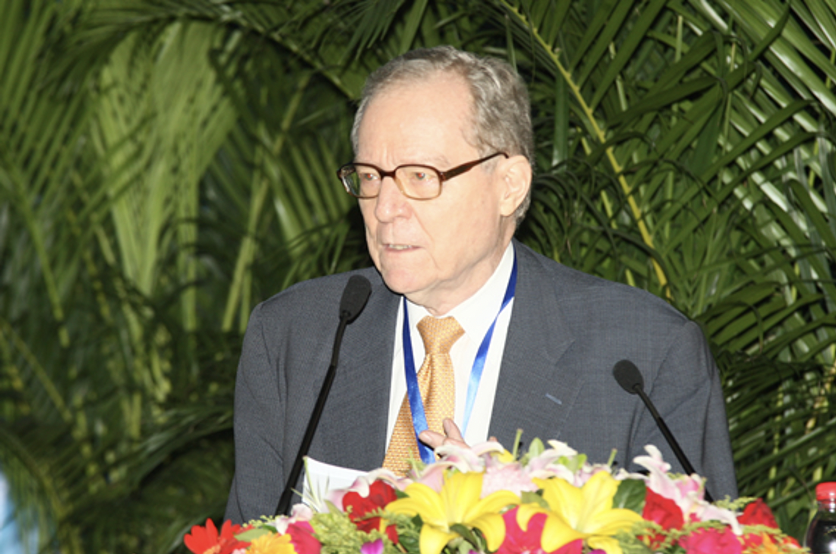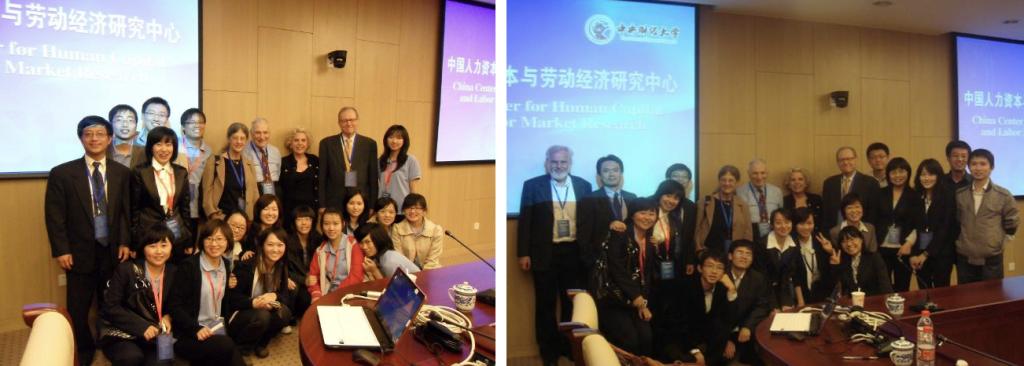In Memoriam: Professor Dale W. Jorgenson
The China Center for Human Capital and Labor Market Research (CHLR) has been saddened by the passing of Harvard University Professor Dale W. Jorgenson. Professor Jorgenson served as a member of the Advisory Board of the CHLR for 14 years. He provided invaluable support and guidance to our China human capital measurement project from its very beginning.
Professor Jorgenson’s research has focused in part on understanding economic growth, emphasizing the role of factor accumulation in explaining growth. His work on improving national accounts led to the development of the international KLEMS (capital, labor, energy, material, and services) datasets. His work particularly focusses on tangible and human capital investment. He co-founded Jorgenson-Fraumeni lifetime income approach to human capital measurement. The J-F approach is the theoretical and practical foundation of the methodology that we applied to estimate China’s human capital stocks. The J-F human capital indexes have been a major component included in the China Human Capital Report series. The Report has been released annually by the CHLR since 2009.
In a Journal of Economic Literature article published in 2018, Professor Jorgenson noted the China Human Capital Report series, writing:
“The most detailed and extensive estimates of human capital for an individual country are given in a series of reports by Li (2017) and his collaborators from the Central University of Finance and Economics in Beijing. The reports of this study have been published annually since 2009 and the most recent report is Human Capital in China, 2017. The estimates of human capital for 2017 are based on the Jorgenson–Fraumeni lifetime income approach for thirty-one provinces of China, Hong Kong, and Taiwan for the period 1985–2015. The measurements include human capital and human capital per capita for urban and rural residents of China, male and female. The study also includes estimates of physical capital at the national and provincial levels for the same period.”
Professor Jorgenson and the late Nobel Laureate Kenneth Arrow were distinguished speakers at the inaugural release of the China Human Capital Report in 2009. The release of the report has become an integral part of the CHLR’s annual International Symposium on Human Capital and Labor Markets since then.

Professor Jorgenson at the first human capital conference in Beijing, 2009.
To add an interesting personal note, before our first release of the China Human Capital Report in 2009, we were trying to get support from the National Statistical Bureau of China for our human capital project. We did not have a connection there. Dale asked me to prepare an official invitation. He then personally went to the Bureau with the invitation letter and invited the then Deputy Director Dr. Xianchun Xu to join our first release.
In 2018, he delivered his remarks via recorded video in celebrating the launch of the tenth release of the China Human Capital Report. He recalled fondly his first trip to the Center and his meetings with the Project team, and he sent his warm wishes to all the participants for a successful conference.

Professor Jorgenson with the Project team in Beijing, 2009.
Every year in the American Economic Association annual meeting, Dale has a very tight schedule. However, in early years, he always arranged a time to meet with me over a coffee or lunch to discuss our human capital project and the CHLR. In the past few years, we regularly had a dinner together during the AEA meeting period, together with his wife Linda and the CHLR special-term professor Barbara Fraumeni. I really enjoyed all the time with Dale and learned so much from him.
Additionally, I joined two international conferences organized by Dale on the World KLEMS data series, one in Japan and the other one in Harvard University in 2018. I was very impressed on how Dale treated each participant so well, like family members. Indeed, the conference filled with family atmosphere in addition to academic exchanges. Dale and Linda seemed to know every participant and showed great care for them.
This year’s human capital conference to be held on December 17, 2022, is a special tribute to honor Professor Dale Jorgenson. We are very grateful to him for his contributions to economics and to the CHLR and its China Human Capital Project.
We thank you for your participation in this year’s conference and for your recognition of the impact that Dr. Jorgenson made at the CHLR and in the profession.
Professor Jorgenson will be very much missed by all of us.
Haizheng Li (Georgia Institute of Technology & Visiting Professor, CHLR)
&
Faculty, staff, and students at the CHLR
Fifty Years Working with Dale Jorgenson
As I believe most of you know, Dale Jorgenson died in June. I am going to share with you some personal memories of working with Dale.
Almost exactly 50 years ago I started working for him as his Research Assistant. As I related to the recent CHLR graduates, I was in the Department of Economics at Wellesley College just after he called in looking for a RA. I had become friendly with the secretaries of the Department, so one of them told me about the phone call. The rest is history!
Initially, I was his only RA. Dale taught me economics one-on-one; this was special. At that time, I did not know how lucky I was. Learning from Dale was an intensive undertaking as it required reading his published articles and as well as those he footnoted. My eventual doctoral studies taught me the core of economics, but Dale taught me how to do research. It was a happenstance that we ended up working together, pairing my love of economic accounting, starting with my undergrad days, with his strong interest in the same. I never remember him being implicitly anything but encouraging. From hearing several of his doctoral advisees describing the experience of working with him, I know that he was very encouraging and supportive of them.
In my second summer of working for him, a scholar who eventually ended up a Full Professor at a top 10 U.S. university was assigned the task of telling me how to construct physical capital service flows (capital input). I already had become something of an expert in this area, but when the scholar told me what to do, I did it. I learned a lesson from that experience: one should trust what you know and do it, even when a prestigious scholar gives you opposite and incorrect instructions. In all the 50 years that I have known Dale, I never heard him raise his voice except when he yelled at the scholar in his office several doors down from mine.
Dale was very serious in those early days. During the first year in his office, I tried to get him to laugh without success. Rumor had it that a doctoral student attended his required graduate econometrics class in a bunny suit to get him to laugh. I believe he started to laugh more regularly after having children; he had primary responsibility for minding and feeding the two of them when they returned home from school in the afternoon.
His econometrics teaching style was famous. He wrote on a chalkboard rapidly without notes, no one could keep up with him, but that is why he gave out complete lecture notes. He also thought in summations notations, say summing something over I, J, K, whatever, rather than with matrix notation. That is extremely difficult to do. In those early years, I had the gall to argue with him even about econometrics. I guess I did not know any better! In any case, I could never keep up with his summation sign argumentative discourses. His wonderful wife Linda once told me that his children wanted to meet me as they had never heard of anyone daring to argue with him, except perhaps another world class economist!
Dale was a genius. Ben Bernanke, who was advised by Dale as an undergraduate and worked for him for 18 months, and who just received the Nobel prize, in a book on monetary policy during the Great Recession, called him “brilliant.” Every once and a while I would observe Dale’s mind going into hyperdrive, when we discussed economics. A number of scholars have commented that he should have won a Nobel Prize.
I am sure that Dale would have preferred if I had attended graduate school or taught at a top ranked university, but what mattered to him was what I could do: performance trumped status!
Just as I was about to start commuting to Washington DC to serves as Chief Economist of the Bureau of Economic Analysis, I started a tradition of going out to lunch with him, copying a Dale modus operandi. Dale and I traded information; he always had something he wanted to know from me and something to tell me, and I always had the same two objectives from my side. After a recent conference, when for obvious reasons we could no longer meet, I realized how important this exchange was to me.
The marvelous Linda noted that Dale and I were so similar as we both intended to continue to do research as long as we possibly could.
I will be eternally grateful for what Dale did for me as an economist and as a person, and I miss him dearly.
— Barbara M. Fraumeni (NBER & Visiting Professor, CHLR)

